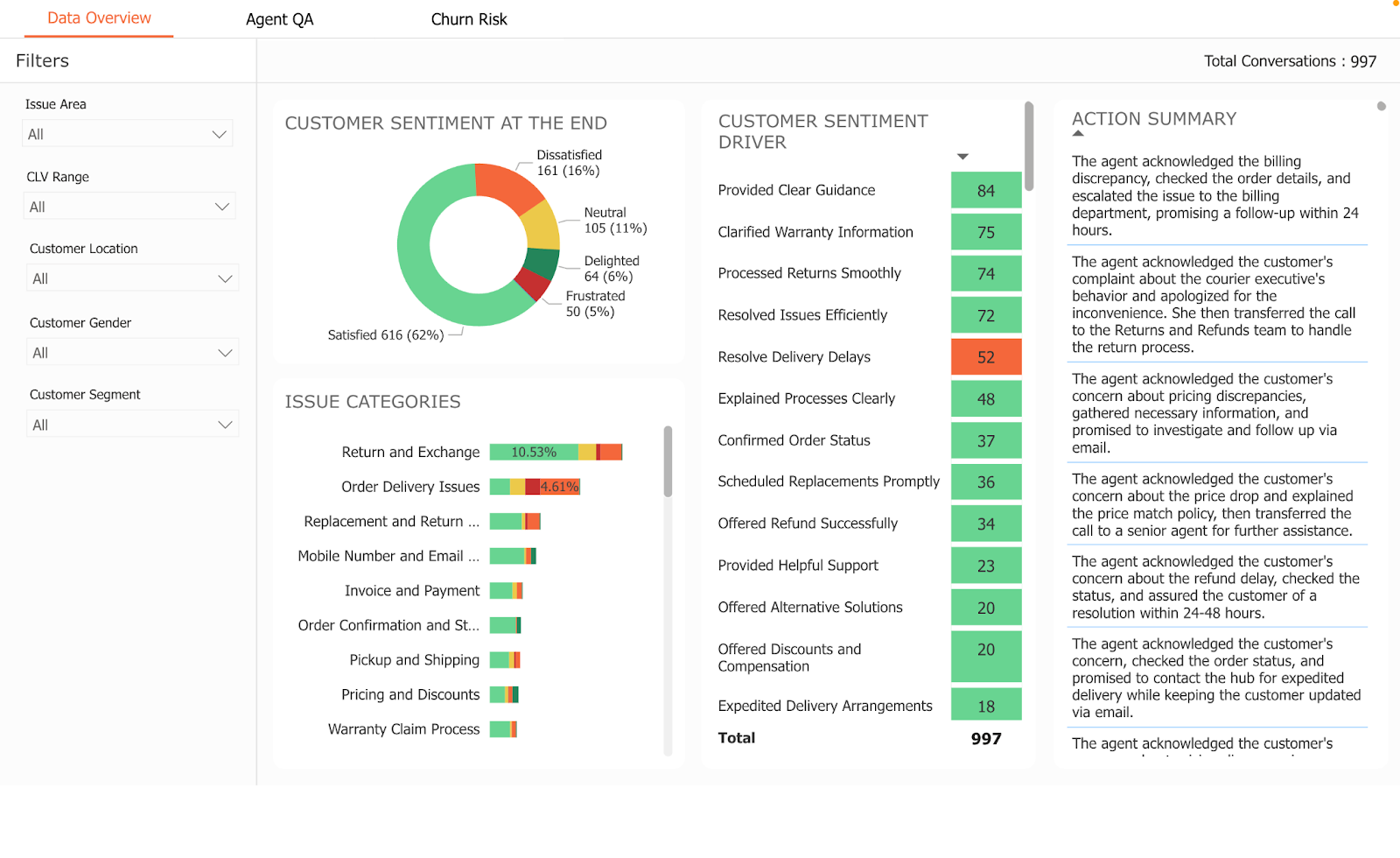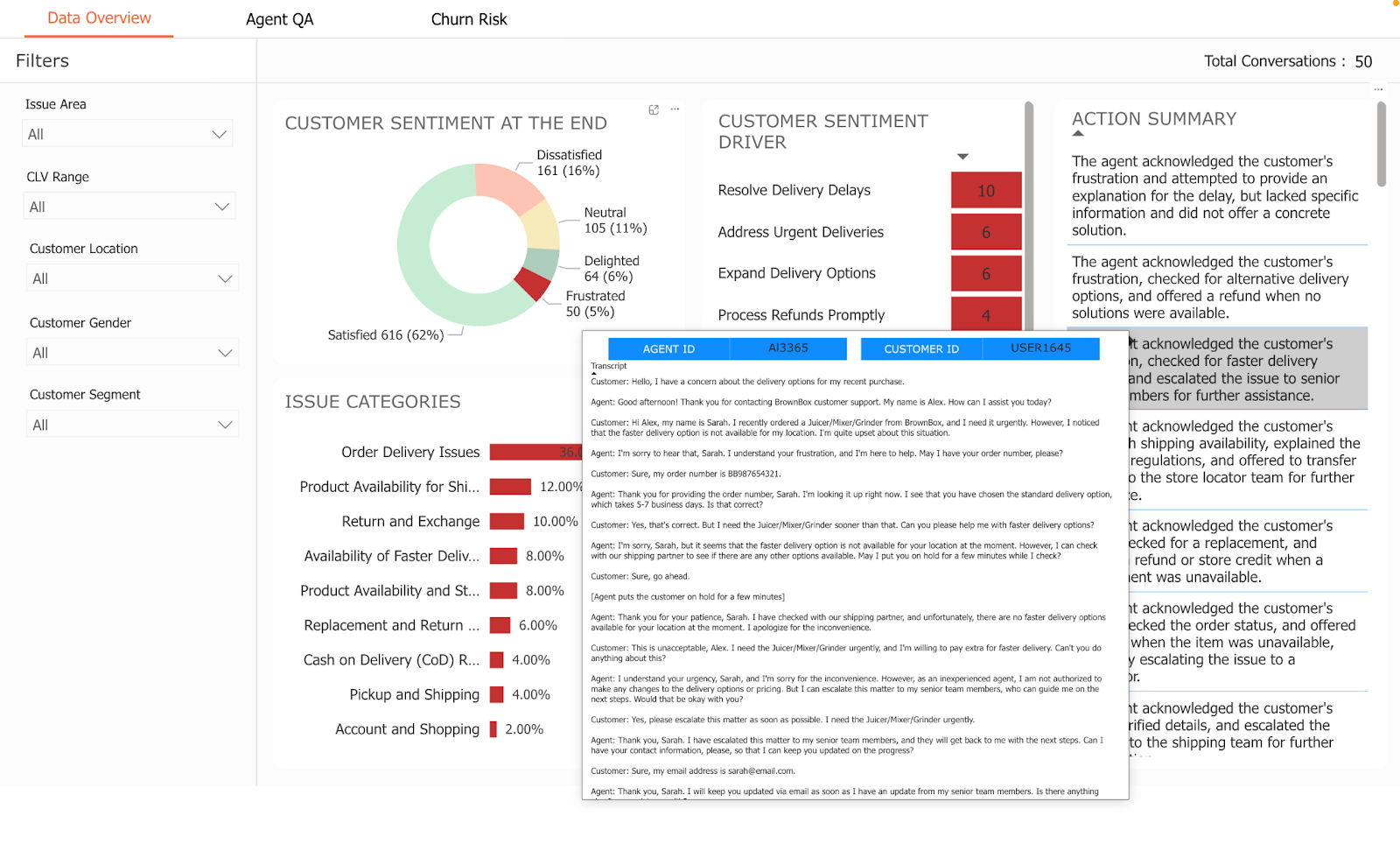In this guide
How can call analytics support customer service teams

In 2025, call analytics in customer service is defined by scale, precision, and real-time intelligence. Advanced speech analytics now captures every conversation, transcribes instantly, and analyzes tone, sentiment, and intent with AI.
For leaders, the impact of call analytics on customer service is clear: decision-grade insights that cut churn, ensure compliance, improve first call resolution, and transform service into a growth engine.
The process: how call analytics supports customer service teams
Step 1 – Capturing and transcribing calls in real time
Modern speech analytics converts every conversation into accurate transcripts using AI speech-to-text. This eliminates the blind spots of manual sampling and gives leaders full visibility into what customers and agents say during interactions.
Step 2 – Analyzing tone, sentiment, and intent with AI
AI models detect emotional intensity, intent shifts, and dissatisfaction signals within conversations. Leaders gain real-time actionable CX insight into dissatisfaction signals, enabling proactive intervention.

Step 3 – Identifying call drivers and recurring patterns
Unsupervised analysis groups conversations by common drivers—delivery delays, billing confusion, technical issues—without relying on pre-tagged keywords. This surfaces new issues automatically, helping leaders address root causes at scale.
Step 4 – Delivering insights instantly to agents and supervisors
Call analytics provides real-time guidance such as compliance reminders, escalation alerts, and next-best actions. Supervisors can track live dashboards with multi-level drill-down reports with access to transcripts, ensuring accountability.

Step 5 – Automating QA, compliance, and escalations
Instead of reviewing a small fraction of calls, modern call monitoring systems apply customizable rules across all interactions.Customizable QA rules flag compliance gaps and missed disclosures are flagged instantly, ensuring compliance at scale.
Step 6 – Feeding insights into dashboards for continuous action
Insights flow into dashboards that break down performance by agent, team, or region. Executives can benchmark KPIs like average handling time and first call resolution, with every metric traceable to the original customer voice.
Step 7 – Tracking outcomes to close the feedback loop
Analytics connects actions to measurable results, whether compliance risk decreases, coaching improves performance, or satisfaction scores rise. This closes the loop and turns analytics into a system of accountability.
How call analytics improves customer service team performance
1. Coaching agents with conversation-level insights
Leaders can see how every agent handles objections, compliance, and emotional cues. Coaching shifts from generic sessions to targeted, measurable, and scalable development programs.

2. Detecting performance gaps automatically
AI surfaces patterns invisible to manual QA, such as missed upsell opportunities or unresolved complaints. Managers can act early, preventing small gaps from scaling into systemic failures.
3. Reducing repeat contacts with driver-based resolutions
Repeat calls erode trust and inflate costs. By exposing the unbiased call drivers behind repeated inquiries, analytics enables fixes, directly improving first call resolution and protecting customer loyalty.
4. Scaling consistent quality across teams
In distributed operations, consistency is a constant challenge. Automated monitoring applies uniform evaluation criteria across all agents, ensuring fairness and maintaining global quality standards.
How call analytics strengthens customer service operations
1. Smarter call routing using real-time intent signals
Calls can be routed based on live intent detection rather than menus or metadata. Customers reach the right agent faster, reducing transfers and improving resolution speed.
2. Reducing average handling time with predictive prompts
Analytics surfaces relevant context during live calls. For leaders, this translates into measurable efficiency gains and higher service quality, achieved without scaling headcount.
3. Prioritizing at-risk customers through churn prediction
By analyzing tone and sentiment, analytics flags customers at risk in real time. Prioritizing these calls helps organizations protect revenue and consumer interest.
4. Automating escalations to the right department
High-risk cases—fraud alerts, cancellations, or regulatory concerns, trigger automatic escalations to senior teams. This reduces compliance risk and reputational damage.
5. Turning every call into decision-grade insights
Instead of reporting from a small sample, analytics processes all conversations. Leaders gain a complete view of systemic issues and align service strategies with business priorities.
Conclusion
The impact of call analytics on customer service in 2025 goes beyond efficiency—it is shaping predictive, anticipatory models where issues are prevented before they reach agents. For leaders, the next frontier is turning service centers into strategic growth engines that protect revenue, reduce churn, and reinforce loyalty.
👉 Forward-looking organizations are already using call analytics to cut churn, raise NPS, and scale quality. Request a demo to see how advanced call analytics can reduce churn and boost NPS in your service teams.
FAQs
Q1: How does call analytics strengthen customer service quality at scale?
By analyzing all calls, not just samples, modern platforms detect sentiment shifts, compliance gaps, and performance issues in real time. Leaders can enforce consistent standards, coach with precision, and maintain service quality across distributed teams.
Q2: How can call analytics proactively reduce customer churn?
Churn risk shows up in subtle frustration cues like negative tone shifts, frequent escalations, or silence during calls. Call analytics identifies these signals early, helping leaders resolve underlying issues such as delivery delays or billing errors before customers leave.
Q3: How does call analytics enable smarter agent coaching and QA?
Analytics reviews every interaction and applies objective evaluation criteria. Leaders receive transcript-backed insights into agent performance, ensuring coaching is consistent, targeted, and scalable.
Q4: How does call analytics improve first call resolution (FCR)?
By clustering recurring drivers and delivering real-time guidance, analytics equips agents to resolve issues on the first interaction. This improves resolution accuracy, lowers operational costs, and raises satisfaction.
Q5: How are leaders leveraging AI-powered call analytics in 2025?
Executives use AI for transcription, emotion detection, intent clustering, churn risk scoring, and compliance monitoring. These continuous insights move customer service beyond case management, enabling leaders to act strategically and anticipate risks before they impact performance.
Do you know what your customers really want?
Analyze customer reviews and automate market research with the fastest AI-powered customer intelligence tool.




